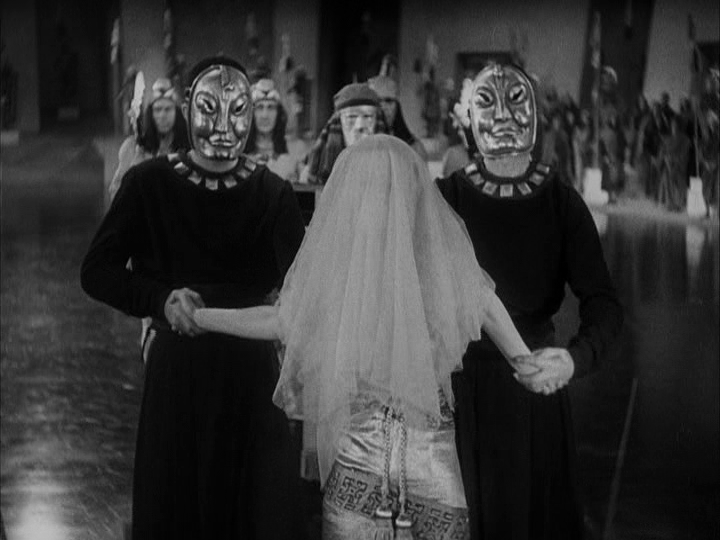I urge you to watch these two films. The 1935 version is truly wonderful, complete with art-deco style caves and art pieces.
Movie Posters for She, produced by Merian Cooper
Note the Art Deco elements, even the classic reclining figure bathed in light and the throwback to classical elements of Greek theatre.
The second is less well done in general. The sets and costumes aren't as stunning or original. Even though the 1965 version followed the novel more closely (for instance, it's actually in Africa this time instead of the arctic), I don't feel it had quite the cinematic power of the 1935 version. That, of course, is not to slight the excellent performances by Peter Cushing and Christopher Lee, two of the greatest horror actors of all time. It's also not meant to slight the beauty of the unearthly Ursula Andress, who commands attention as Ayesha.
The real key to the success of the film is the character of Ayesha. Ursula Andress, though a fine actress in her own right, couldn't radiate the eternal passion of immortal tragic love and furious devotional jealousy—the pure lust for living that Helen Gahagan reveals. Helen's Ayesha is a tragic character of death with whom we fall in love, rather than Andress, who simply inspires desire. Her character is cold, calculating, lustful, and we cannot sympathize with her. She is two-dimensional, a goddess. Kallikrites/Leo ends up walking through the flame of eternal life, and simply waiting for Ayesha to be reborn once more, even shrugging off the love given to him by Ustane (played by the stunning Rosenda Monteros) that saved him in the first place. This is, I suppose, convenient for the sequel The Vengeance of She, but there's no real important lesson to learn, and we never establish enough connection with either Kallikrites/Leo or Ayesha to understand why the love is such a big deal. We do, however, feel adoration for Peter Cushing's Professor Holly, fright for Christopher Lee's Bilali, and sympathy for the gorgeous and sincere Ustane.
The captivating Helen Gahagan
The thing is, the 1935 version had a definite message. The message was that true love can only be had when one grows old and dies and "hopes to see them again someday." This message is conveyed through the naïve Tanya, who tries to dissuade Leo from walking through the eternal flame and uniting himself with Ayesha. Ayesha is revealed to be jealous beyond belief and vain enough to take joy in making Leo watch Tanya die without revealing her identity (thankfully he does, and ceases the sacrifice). This reveals that Ayesha does not so much want to make Leo hurt as much as she wants to satisfy her ravenous desire for his love for her to be complete. But Tanya thinks that Ayesha's type of love—the jealous obsession she has for her only equal, the only person "whose passion for life is as grat as [her] own"—isn't human. Instead, what love is to Tanya is simple. "Sharing life...growing old together, and when one dies, hoping to see them again someday."
This is a complex argument, and essentially implies that to truly love something, you must love something that is dying. Love and death. This argument is implied in films like Groundhog Day, in plays like Shakespeare's Hamlet, and in Wagner's Tristan und Isolde. Roger Scruton has a book about this very association.
In other words, whereas the 1965 film is a great film to watch if you are a Peter Cushing or a Christopher Lee fanboy (as am I), or just want to see Ursula Andress—it's always worth it. But really, it is an unsuccessful movie, especially if compared with the 1935 version directed by Cooper. Despite the minor characters being truly two-dimensional, Ayesha played by Helen Gahagan is a truly rich character with a depth that engages with themes that have been central to our literature since time immemorial: the terrible consequences of vanity, the horror of immortality, and the ephemeral nature of true love.
~~~
I think that the "star" system of rating movies is highly inadequate. I look for different things in movies, so I would rate them on different scales. Here is what I propose: To take different aspects of the movie, and give ratings for each one, with no overall "score." Judge the movie based on what it trying to do, not what you were wanting. That system works surprising well for a lot in life.
Here's what the numbers generally mean.
1 - objectively deplorable
2 - terrible
3 - bad
4 - below average
5 - mediocre
6 - could use improvement
7 - enjoyed it despite reservations
8 - great, with minor problems
9 - incredible
10 - inspired by genius or supernatural occurrence
For the 1935 version of Merian C. Cooper's She:
Main Character ~ 8
Supporting Characters ~ 6
Cinematography ~ 7
Set and Costume ~ 7+
Plot ~ 6+
Dialogue ~ 6
Music ~ 6+
Narrative Concern ~ 8
Effects ~ 6
The 1965 version of She:
Main Character ~ 6
Supporting Characters ~ 7+
Cinematography ~ 6
Set and Costume ~ 7
Plot ~ 6
Dialogue ~ 7
Music ~ 5
Narrative Concern ~ 5
Effects ~ 6
Further note: I have not watched the silent version from 1925, nor have I watched The Vengeance of She. I will review those at a later time in connection with this post.







No comments:
Post a Comment